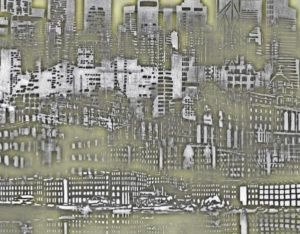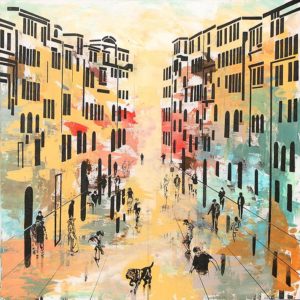Have you ever pondered the ways in which art affects your emotional life? If so, you’ll likely agree that it does not do to simply claim that art has the ability to influence emotion. No, art has the power to rule and change emotion, and is capable of transforming one’s energetic feelings of indifference to hopefulness, sincerity to passion, affection to terror, and the list goes on and on. For better or worse, art is a mighty force that rips through and rearranges the heart.
Phil Davis, a West Midlands-based fine artist, knows a thing or two about how art relates to human emotion. As is stated on his website, Mr. Davis’ “emotionally-charged paintings use a technique called Stencilism, which involves hand crafting stencils of the subjects he wishes to produce and incorporating them onto surfaces of intense, bold colours in experimental and unconventional ways. Establishing this technique has enabled him to express the extreme emotional sensations in which he is interested, and apply them successfully to canvas.”
Segmation’s Exclusive Interview with Artist Phil Davis
Segmation recently had the pleasure of interviewing Phil Davis, getting an inside look at his artistic process, passions and pursuits. Read on to learn more.
S: How did you get your start in art? Did you have an art mentor, or did you go it alone?
P: I was able to draw competently from a very young age, maybe two- or three-years-old. My family and certain teachers at primary school recognized my potential and encouraged me to keep going. There were one or two lecturers in college whom I still consider mentors within the frame of that time period; they introduced me to the aspect of fine art that opened all sorts of creative possibilities. In terms of my career itself, I went at it alone but with that same moral support and encouragement from my family and closest friends. Through all the ups and downs, I’m lucky that I knew it was the direction I wanted to go.
S: Tell me a little bit about your art training. Did you receive any formal training, or are you self-taught?
P: I studied Art and Design at Kidderminster College, followed by a degree in Fine Art and Sculpture at Loughborough University. However, as a painter I am self-taught in all aspects – stylistically, technically, and how I  compose my work. College and University opened up my mind creatively but didn’t teach me anything about painting, and I was still too young to know who I was as an artist. I only began finding that out after finishing my education and leaving it behind.
compose my work. College and University opened up my mind creatively but didn’t teach me anything about painting, and I was still too young to know who I was as an artist. I only began finding that out after finishing my education and leaving it behind.
S: What are you most passionate about? How is that expressed in your art?
P: A constant passion is music. Music is of equal importance to painting because it teaches me to paint in ways I would otherwise not comprehend or attempt to reach. The emotional reaches of the best music are inexplicable and without boundary. Whatever the genre may be, I love to translate musical notes and vocal sounds into painted textures and expressions of emotion. I also enjoy traveling and embracing new cultures, but sometimes I love travel simply for observing the physicality of the everyday life, whether it be touching the architecture, the countryside or just watching the people. Portraying a sense of physicality in my painting is important to me.
S: Where do you want to be (in your art career/journey) in 5 years? 10 years?
 P: Those times are too long away for me to visualise where I want to be, or even what kind of artist I’ll be. A lot can happen in five years, let alone ten years. Maybe I’ll have artistically advanced in ways I can’t yet see, and my career may be in places that I cannot comprehend, so ask me where I am in five years time and if I’m content with where I am. The only ambitions I can think about and make sense of are those that are going on now, and those that I’ll prepare for the short-term future.
P: Those times are too long away for me to visualise where I want to be, or even what kind of artist I’ll be. A lot can happen in five years, let alone ten years. Maybe I’ll have artistically advanced in ways I can’t yet see, and my career may be in places that I cannot comprehend, so ask me where I am in five years time and if I’m content with where I am. The only ambitions I can think about and make sense of are those that are going on now, and those that I’ll prepare for the short-term future.
S: If there was one historical artist you could choose to interview, who would it be and why?
P: Ironically, there are no painters in the history of art that I feel compelled to interview. When it comes to the painters who have been a great influence on me, I’d rather appreciate and relate to the actual art and let the work speak volumes, so I don’t feel the need to ask any questions that relate to their practice or who they were. I’m curious enough in my own painting process and how I personally evolve as an artist to ask myself enough questions on what I’m doing and where I’m going. I drive myself very hard sometimes because I want to be the best I can be in my field. However, if you mean recent history and artists in all fields then I’ll happily hang out with Stanley Kubrick or Orson Welles and let them do all the talking.
 S: What is the main thing you wish others understood about you, your art, or your artistic process?
S: What is the main thing you wish others understood about you, your art, or your artistic process?
P: Why I paint the way I paint, and the nature of my style. For my work I like to study the boundaries and norms of both classical and abstract art and fuse the two ways of painting together. Whatever the subject, my interest is in juxtaposing these two very different methods, one meticulous and the other expressive, in order to create images that are hopefully profound reflections of those attempts to be both abstract and intense, but also refined and purposeful. I hope that my work portrays the physicality of the subject, whilst also challenging the limitless possibilities of the painting process. My hope is that on this journey I will discover new ways of depicting and evolving my own art.
Discover more about Phil Davis’ art by visiting his website. Don’t forget to check him out on Twitter.
What emotions does this artist’s work evoke in you? Feel free to share with us in the section below.
Read more Segmation blog posts about art and color:
How to Live an Artist’s Dream: a Tale of Two Brothers
FEATURED ARTIST: JASMINE FLYNN
FEATURED ARTIST: OMASTE WITKOWSKI
Be an Artist in 2 minutes with Segmation SegPlay® PC (see more details here)








